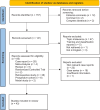Endoscopic Combined Intrarenal Surgery: best practices and future perspectives
- PMID: 39226443
- PMCID: PMC11554270
- DOI: 10.1590/S1677-5538.IBJU.2024.9921
Endoscopic Combined Intrarenal Surgery: best practices and future perspectives
Abstract
Introduction: Endoscopic Combined Intrarenal Surgery (ECIRS) has emerged as a promising technique for the management of large and complex kidney stones, potentially offering advantages over traditional Percutaneous Nephrolithotomy (PCNL). This study aims to evaluate best practices, outcomes, and future perspectives associated with ECIRS.
Materials and methods: A comprehensive PubMed search was conducted from 2008 to 2024, using MESH terms and the following key words: "ECIRS" and "Endoscopic Combined Intrarenal Surgery" The search yielded 157 articles, including retrospective cohort studies, two randomized controlled trials (RCTs), and four meta-analyses comparing ECIRS with PCNL. Most important findings were summarized regarding indications, patient positioning, kidney access, tract size, surgical outcomes, and complications.
Results: ECIRS demonstrated higher stone-free rate, lower complication rate, and a reduced need for multiple procedures compared to traditional PCNL. Additionally, ECIRS has the potential to integrate new technologies to further enhance outcomes.
Conclusion: ECIRS demonstrates significant advantages in the management of large kidney stones. Future research should focus on well-designed RCTs to provide robust evidence of its efficacy, safety, and cost-effectiveness, potentially establishing ECIRS as the first option treatment for complex kidney stones.
Keywords: Kidney; Lithotripsy; Urinary Calculi.
Copyright® by the International Brazilian Journal of Urology.
Conflict of interest statement
None declared.
References
-
- Skolarikos A, Jung H, Neisius A, Petřík A, Somani B, Tailly T, et al. EAU Guidelines on Urolithiasis . Edn. presented at the EAU Annual Congress Paris; 2024. [Internet]. Avaliable at. < https://uroweb.org/guidelines/urolithiasis >.
Publication types
MeSH terms
LinkOut - more resources
Full Text Sources
Medical

